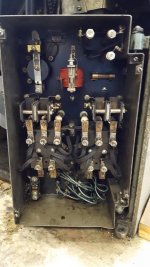lohring
Plastic
- Joined
- Apr 27, 2013
- Location
- Oregon USA
After running fine for the past year, my 1947 square dial, motor generator, 10ee lathe's spindle started to slow down then return to the set speed. It rapidly got worse and worse. I spent some time on this forum studying the excellent posts on the electrical system and decided it had to be the 2000 ohm resistor at the top of the DC panel. I removed and tested it, and the resistance was fine. However, while removing the resistor, I noticed that the screw holding one of the wires was loose. I reassembled the resistor, tightening everything and the lathe ran fine.
The moral of all this is despite the appearance, the motor generator DC drive system is electrically simple and tough. Check out the simple things before doing something drastic. This forum has some great wisdom on the machine.
Lohring Miller
The moral of all this is despite the appearance, the motor generator DC drive system is electrically simple and tough. Check out the simple things before doing something drastic. This forum has some great wisdom on the machine.
Lohring Miller







